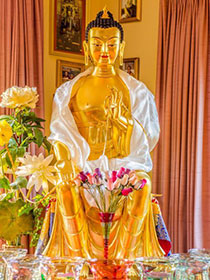- Home
- FPMT Homepage
Foundation for the Preservation of the Mahayana Tradition
The FPMT is an organization devoted to preserving and spreading Mahayana Buddhism worldwide by creating opportunities to listen, reflect, meditate, practice and actualize the unmistaken teachings of the Buddha and based on that experience spreading the Dharma to sentient beings. We provide integrated education through which people’s minds and hearts can be transformed into their highest potential for the benefit of others, inspired by an attitude of universal responsibility and service. We are committed to creating harmonious environments and helping all beings develop their full potential of infinite wisdom and compassion. Our organization is based on the Buddhist tradition of Lama Tsongkhapa of Tibet as taught to us by our founders Lama Thubten Yeshe and Lama Thubten Zopa Rinpoche.
- Willkommen
Die Stiftung zur Erhaltung der Mahayana Tradition (FPMT) ist eine Organisation, die sich weltweit für die Erhaltung und Verbreitung des Mahayana-Buddhismus einsetzt, indem sie Möglichkeiten schafft, den makellosen Lehren des Buddha zuzuhören, über sie zur reflektieren und zu meditieren und auf der Grundlage dieser Erfahrung das Dharma unter den Lebewesen zu verbreiten.
Wir bieten integrierte Schulungswege an, durch denen der Geist und das Herz der Menschen in ihr höchstes Potential verwandelt werden zum Wohl der anderen – inspiriert durch eine Haltung der universellen Verantwortung und dem Wunsch zu dienen. Wir haben uns verpflichtet, harmonische Umgebungen zu schaffen und allen Wesen zu helfen, ihr volles Potenzial unendlicher Weisheit und grenzenlosen Mitgefühls zu verwirklichen.
Unsere Organisation basiert auf der buddhistischen Tradition von Lama Tsongkhapa von Tibet, so wie sie uns von unseren Gründern Lama Thubten Yeshe und Lama Thubten Zopa Rinpoche gelehrt wird.
- Bienvenidos
La Fundación para la preservación de la tradición Mahayana (FPMT) es una organización que se dedica a preservar y difundir el budismo Mahayana en todo el mundo, creando oportunidades para escuchar, reflexionar, meditar, practicar y actualizar las enseñanzas inconfundibles de Buda y en base a esa experiencia difundir el Dharma a los seres.
Proporcionamos una educación integrada a través de la cual las mentes y los corazones de las personas se pueden transformar en su mayor potencial para el beneficio de los demás, inspirados por una actitud de responsabilidad y servicio universales. Estamos comprometidos a crear ambientes armoniosos y ayudar a todos los seres a desarrollar todo su potencial de infinita sabiduría y compasión.
Nuestra organización se basa en la tradición budista de Lama Tsongkhapa del Tíbet como nos lo enseñaron nuestros fundadores Lama Thubten Yeshe y Lama Zopa Rinpoche.
A continuación puede ver una lista de los centros y sus páginas web en su lengua preferida.
- Bienvenue
L’organisation de la FPMT a pour vocation la préservation et la diffusion du bouddhisme du mahayana dans le monde entier. Elle offre l’opportunité d’écouter, de réfléchir, de méditer, de pratiquer et de réaliser les enseignements excellents du Bouddha, pour ensuite transmettre le Dharma à tous les êtres. Nous proposons une formation intégrée grâce à laquelle le cœur et l’esprit de chacun peuvent accomplir leur potentiel le plus élevé pour le bien d’autrui, inspirés par le sens du service et une responsabilité universelle. Nous nous engageons à créer un environnement harmonieux et à aider tous les êtres à épanouir leur potentiel illimité de compassion et de sagesse. Notre organisation s’appuie sur la tradition guéloukpa de Lama Tsongkhapa du Tibet, telle qu’elle a été enseignée par nos fondateurs Lama Thoubtèn Yéshé et Lama Zopa Rinpoché.
Visitez le site de notre Editions Mahayana pour les traductions, conseils et nouvelles du Bureau international en français.
Voici une liste de centres et de leurs sites dans votre langue préférée
- Benvenuto
L’FPMT è un organizzazione il cui scopo è preservare e diffondere il Buddhismo Mahayana nel mondo, creando occasioni di ascolto, riflessione, meditazione e pratica dei perfetti insegnamenti del Buddha, al fine di attualizzare e diffondere il Dharma fra tutti gli esseri senzienti.
Offriamo un’educazione integrata, che può trasformare la mente e i cuori delle persone nel loro massimo potenziale, per il beneficio di tutti gli esseri, ispirati da un’attitudine di responsabilità universale e di servizio.
Il nostro obiettivo è quello di creare contesti armoniosi e aiutare tutti gli esseri a sviluppare in modo completo le proprie potenzialità di infinita saggezza e compassione.
La nostra organizzazione si basa sulla tradizione buddhista di Lama Tsongkhapa del Tibet, così come ci è stata insegnata dai nostri fondatori Lama Thubten Yeshe e Lama Zopa Rinpoche.
Di seguito potete trovare un elenco dei centri e dei loro siti nella lingua da voi prescelta.
- 欢迎 / 歡迎
简体中文
“护持大乘法脉基金会”( 英文简称:FPMT。全名:Foundation for the Preservation of the Mahayana Tradition) 是一个致力于护持和弘扬大乘佛法的国际佛教组织。我们提供听闻,思维,禅修,修行和实证佛陀无误教法的机会,以便让一切众生都能够享受佛法的指引和滋润。
我们全力创造和谐融洽的环境, 为人们提供解行并重的完整佛法教育,以便启发内在的环宇悲心及责任心,并开发内心所蕴藏的巨大潜能 — 无限的智慧与悲心 — 以便利益和服务一切有情。
FPMT的创办人是图腾耶喜喇嘛和喇嘛梭巴仁波切。我们所修习的是由两位上师所教导的,西藏喀巴大师的佛法传承。
繁體中文
護持大乘法脈基金會”( 英文簡稱:FPMT。全名:Found
ation for the Preservation of the Mahayana Tradition ) 是一個致力於護持和弘揚大乘佛法的國際佛教組織。我們提供聽聞, 思維,禪修,修行和實證佛陀無誤教法的機會,以便讓一切眾生都能 夠享受佛法的指引和滋潤。 我們全力創造和諧融洽的環境,
為人們提供解行並重的完整佛法教育,以便啟發內在的環宇悲心及責 任心,並開發內心所蘊藏的巨大潛能 — 無限的智慧與悲心 – – 以便利益和服務一切有情。 FPMT的創辦人是圖騰耶喜喇嘛和喇嘛梭巴仁波切。
我們所修習的是由兩位上師所教導的,西藏喀巴大師的佛法傳承。 察看道场信息:
- FPMT Homepage
- News/Media
-
- Study & Practice
-
-
- About FPMT Education Services
- Latest News
- Programs
- New to Buddhism?
- Buddhist Mind Science: Activating Your Potential
- Heart Advice for Death and Dying
- Discovering Buddhism
- Living in the Path
- Exploring Buddhism
- FPMT Basic Program
- FPMT Masters Program
- FPMT In-Depth Meditation Training
- Maitripa College
- Lotsawa Rinchen Zangpo Translator Program
- Universal Education for Compassion & Wisdom
- Online Learning Center
-
- Prayers & Practice Materials
- Overview of Prayers & Practices
- Full Catalogue of Prayers & Practice Materials
- Explore Popular Topics
- Benefiting Animals
- Chenrezig Resources
- Death & Dying Resources
- Lama Chopa (Guru Puja)
- Lama Zopa Rinpoche: Compendium of Precious Instructions
- Lama Zopa Rinpoche: Life Practice Advice
- Lama Zopa Rinpoche Practice Series
- Lamrim Resources
- Mantras
- Prayer Book Updates
- Purification Practices
- Sutras
- Thought Transformation (Lojong)
- Audio Materials
- Dharma Dates - Tibetan Calendar
- Translation Services
- Publishing Services
- Ways to Offer Support
- Prayers & Practice Materials
-
- Teachings and Advice
- Find Teachings and Advice
- Lama Zopa Rinpoche Advice Page
- Lama Zopa Rinpoche: Compendium of Precious Instructions
- Lama Zopa Rinpoche Video Teachings
- ༧སྐྱབས་རྗེ་བཟོད་པ་རིན་པོ་ཆེ་མཆོག་ནས་སྩལ་བའི་བཀའ་སློབ་བརྙན་འཕྲིན།
- Podcasts
- Lama Yeshe Wisdom Archive
- Buddhism FAQ
- Dharma for Young People
- Resources on Holy Objects
- Teachings and Advice
-
-
*If a menu item has a submenu clicking once will expand the menu clicking twice will open the page.
-
-
- Centers
-
- Teachers
-
- Projects
-
-
-
-
*If a menu item has a submenu clicking once will expand the menu clicking twice will open the page.
-
-
- FPMT
-
-
-
-
-
My approach is to expose your ego so that you can see it for what it is. Therefore, I try to provoke your ego. There’s nothing diplomatic about this tactic. We’ve been diplomatic for countless lives, always trying to avoid confrontation, never meeting our problems face to face. That’s not my style. I like to meet problems head on and that’s what I want you to do, too.
Lama Thubten Yeshe
-
-
-
- Shop
-
-
-
The Foundation Store is FPMT’s online shop and features a vast selection of Buddhist study and practice materials written or recommended by our lineage gurus. These items include homestudy programs, prayers and practices in PDF or eBook format, materials for children, and other resources to support practitioners.
Items displayed in the shop are made available for Dharma practice and educational purposes, and never for the purpose of profiting from their sale. Please read FPMT Foundation Store Policy Regarding Dharma Items for more information.
-
-
FPMT Community: Stories & News
31
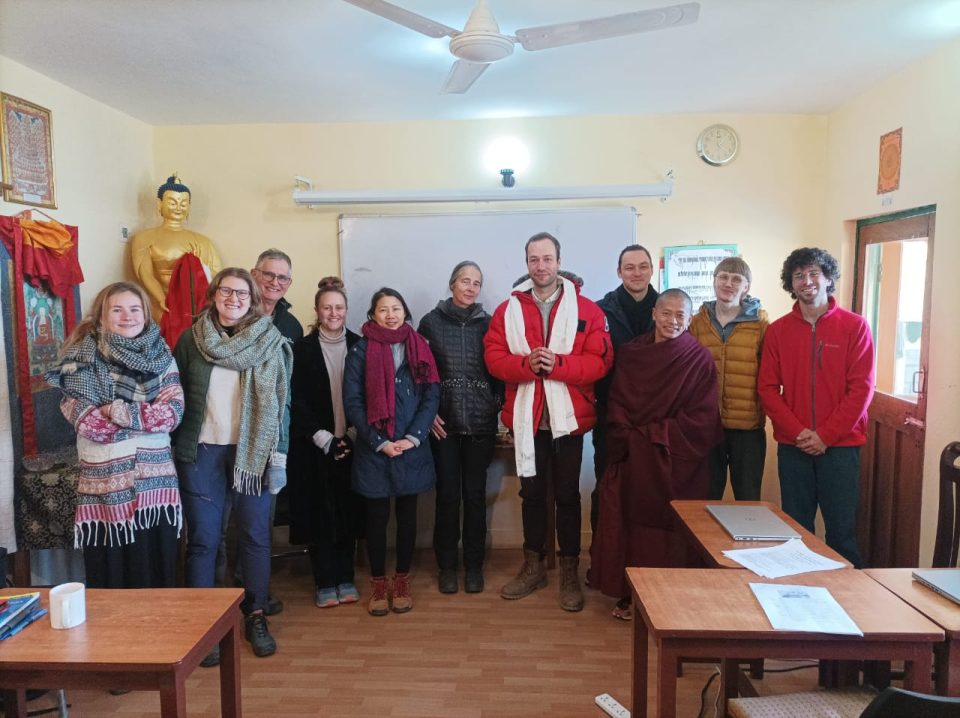
Lotsawa Rinchen Zangpo Translator Program participants.
Lotsawa Rinchen Zangpo Translator Program (LRZTP) is an FPMT project in Dharamsala, Himachal Pradesh, India. LRZTP has produced many gifted Dharma interpreters-translators for FPMT Dharma centers since its conception over twenty-three years ago. In addition to the two-year intensive training program, LRZTP also runs short Tibetan language courses and offers private online Tibetan language lessons.
The latest interpreters training course, LRZTP9, successfully began in April 2023, with twelve new students. At the completion of their first year of the two-year program, we are happy to share this report from LRZTP on the progress of the students:
For the Lotsawa Rinchen Zangpo Translator Program students of the ninth edition it all began on April 24, 2023. Their journey through the mountains and valleys of Tibetan grammar has been an adventurous one. But they have made it! The whole group graduated with wonderful results on April 19, 2024 and had their well deserved holiday.
And then on May 6 they began their second and final year of LRZTP9. The new journey is quite different compared to the first year. The focus in year one was the language. Students learned loads of vocabulary as well as intricacies of Tibetan grammar (both colloquial and literary). They passed tests and checked themselves every day during conversation classes.
The new journey brings new adventures. In the second year the focus is on Dharma in Tibetan. English is no longer there to help understand and explain. Now everything is in Tibetan. And the teachers of the program are now our wonderful geshes who will lead the students through such topics as the Lamrim (Stages of the Path), Dura (Collected Topics) or The Thirty-Seven Practices of a Bodhisattva.
This of course brings new challenges. That is why every afternoon the students will still learn one on one with their conversation tutors to help clarify difficult points. The core of the geshes’ team to guide students through the second year is: Geshe Lhundup Kalsang, Geshe Phuntsok Legmon, Geshe Tsering Samten, and Geshe Tsering Dargye. All of them have the highest qualifications to teach these topics.
Very soon the students will begin their debate practice and later in the course of the year the interpretation workshops.
One of the new and amazing teachers in the second year of LRZTP9 will also be Geshema Kalsang Wangmo who very soon will begin giving classes on interpretation.
The vision of the school’s founder Lama Zopa Rinpoche was to provide students with the best possible tools to educate and mold them into fine translators and interpreters of the Buddhist teachings. For that reason it is also necessary for the participants of the program to spice up their motivation by meeting with accomplished teachers, translators and graduates of previous courses.
In the last module of the first year, one of the distinguished guests of LRZTP was Dr. Paul Hackett of Columbia University, the author of Learning Classical Tibetan and A Tibetan Verb Lexicon among many other books. He graciously accepted the invitation to meet the students on Zoom and gave a very inspiring talk. Another guest, this time in person, was Alvaro Fernandez Pereto, graduate of LRZTP8 and currently a student of a Sakya shedra (monastic college) in Dehradun. He encouraged everyone to keep on persevering in their studies and talked about the very demanding schedule of his monastic studies. Meetings like these always help to keep the flame of motivation burning.
We wish all our amazing students more success in the second year of their LRZTP adventure. Their determination and perseverance despite various obstacles and a demanding schedule is highly admired. We also welcome new students who joined our school in order to learn in individual one-on-one sessions. They have come from South Korea, Bolivia, and Buryatia. We are always open for anyone who would like to study with us, so please, check our website for information on individual sessions.
Meanwhile another great team of students completed, in March 2024, their Advanced Level I (third year) of the Foundations in Tibetan Language online program. We wish to congratulate all of them, too. Online classes began on Advanced Level 2: Focus on Dharma, May 29.
Lotsawa Rinchen Zangpo Translator Program is dedicated to providing the best possible platform for anyone who wishes to study Tibetan language either to be able to translate Dharma or for their own purpose. The language is taught on all levels, from elementary to advanced. You can learn both colloquial as well as literary Tibetan.
Check the LZRTP website for dates for LRZTP10 as this information becomes available: www.lrztp.org
Foundation for the Preservation of Mahayana Tradition (FPMT), is a Tibetan Buddhist organization dedicated to the transmission of the Mahayana Buddhist tradition and values worldwide through teaching, meditation and community service.
17
May 2024 E-News is Available Now!
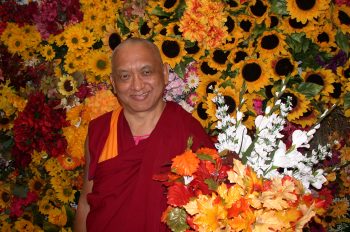
Lama Zopa Rinpoche with flowers, October 2003. Photo by Ven. Roger Kunsang.
This month’s e-news brings you important news, updates, and causes for rejoicing regarding:
- An update on the Stupa of Complete Victory at Kopan Monastery
- Teachings from Lama Yeshe and Lama Zopa Rinpoche
- Meritorious activities on Saka Dawa for the entire FPMT organization
- A report on the Heart Sutra Retreat at Kopan Monastery
- Center and regional news
- Resources for your study and practice
- Opportunities and changes within the organization
and much more!
Please read this month’s e-news in its entirety.
Have the e-News translated into your native language by using our convenient translation facility located on the right-hand side of the page.
Visit our subscribe page to receive the monthly FPMT International Office e-News directly in your email inbox.
- Tagged: enews, fpmt enews
16
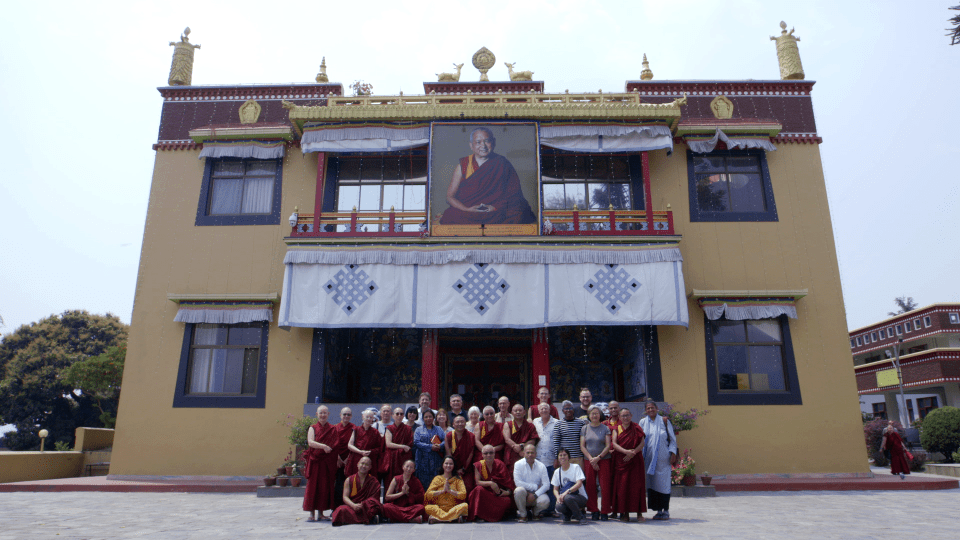
Caption: Group participating in the Asia Regional Consultations at Kopan Monastery. Photo by Kira Dane.
The first of the four regional consultations planned in 2024 to pave the way for the CPMT 2025 meeting took place at Kopan Monastery on April 14-15. Thirty onsite and a dozen online participants joined, representing almost all the centers, projects and services from South Asia and East and South-East Asia, and including eight monks and nuns from Kopan.
Selina Foong, regional coordinator for East and South-East Asia reports.
After seemingly endless regional meetings on Zoom, it felt so right that the first time we met in person again after four long years was at Kopan Monastery… the place where it all began for many of us, and from where ripples of the holy Dharma continue to spread in all directions.
It was a healthy turnout for our regional meeting on April 14 and 15, with all the FPMT East & South-East Asian FPMT centers represented by their respective center directors, Spiritual Program Coordinators, and other key personnel. Those unable to travel to Kopan were equally enthusiastic, joining via Zoom and actively participating in discussions as if they were sitting right next to us in the Kopan Library!
We were thrilled to be joined as well by representatives from South Asia FPMT centers in India and Nepal, including geshes and geshemas from Kopan, during the opening and closing plenary sessions of the meeting, in which Khen Rinpoche Geshe Chonyi and Ven. Roger Kunsang also participated. Together with our meeting facilitators (FPMT board members Karuna Cayton and Dale Davis, and Center Services director Francois Lecointre), this made for a large dynamic group with great camaraderie and family feeling.
The meeting theme was “Advancing our Gurus’ Vision of a World Guided by Compassion & Wisdom” so in between the plenary sessions, we divided into our respective regional groups – ESEA, India. and Nepal – to discuss the way forward for our beloved FPMT organization, progressing on from the FPMT global online survey conducted in early 2024. Rich and fruitful discussions focused on the four main topics: Education, Community Services and Interfaith, Modern Technologies and Communications, and Leadership. Each group was then given the opportunity to present their summaries at the closing plenary session, followed by a delightful buffet lunch in Boudha.
This consultation of the Asian FPMT affiliates from East & South-East Asia, India and Nepal, was the first to be held by FPMT Inc. and International Office, and will be followed by similar consultations in other regions throughout the year which will pave the way for CPMT, due to be held in Kopan Monastery in April 2025. We look forward to it very much. May the unmistaken reincarnation of Kyabje Lama Zopa Rinpoche swiftly return!
The second of the four regional consultations planned in 2024 to pave the way for the CPMT 2025 took place in Jamyang London on April 26-28. Forty onsite participants joined, representing centers, projects, and services from a dozen of European countries. We’ll share more detail on this successful event soon. Next regional consultations are planned in Land of Medicine Buddha for affiliates from North and Latin America, September 6-8; and in Atisha Centre for affiliates from Australia and New-Zealand, October 25-28.
Foundation for the Preservation of Mahayana Tradition (FPMT), is a Tibetan Buddhist organization dedicated to the transmission of the Mahayana Buddhist tradition and values worldwide through teaching, meditation and community service.
- Tagged: cpmt 2025, regional meetings
15
2024 Heart Sutra Retreat at Kopan Monastery
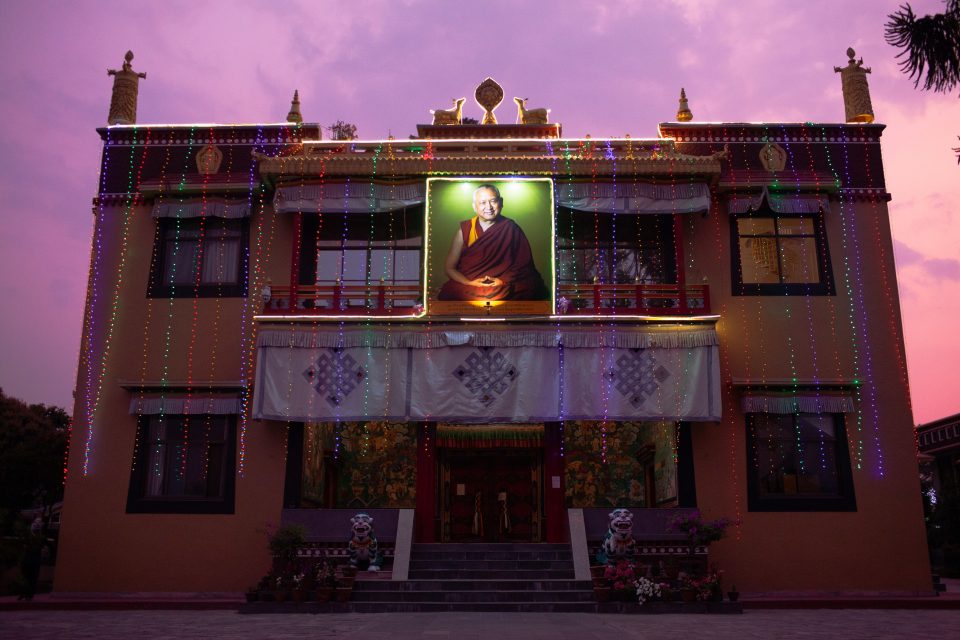
Kopan Monastery illuminated during the Heart Sutra Retreat. Photo by Kira Dane.
Following the commemoration activities at Kopan Monastery honoring the one-year anniversary of Lama Zopa Rinpoche showing the aspect of passing away, a Heart Sutra Retreat was held from April 15-20, 2024 with commentary by His Eminence the 104th Ganden Tripa, meditations led by Ven. Steve Carlier, and evening sessions with short extracted videos of Lama Zopa Rinpoche teaching a topic related to emptiness. Please read an inspiring overview of this joyous retreat provided by Kopan Monastery:
The Heart Sutra Retreat began with a joyous welcome and introduction to Kopan and the event by Ven. Thubten Kalden, who had kindly stepped in to replace Ven. Thubten Khadro, Kopan’s SPC, while she is away taking care of her ailing father. After dinner, we were joined by Ven. Roger Kunsang who told us how pleased he was that so many people, a bit more than 200, were attending this retreat, which had been specifically organized to fulfill one of Lama Zopa Rinpoche’s wishes. Ven. Steve Carlier then set the tone for the retreat with his opening remarks in his trademark laid-back style of presentation.
In accordance with Lama Zopa Rinpoche’s tradition for retreat, each day began at 5:30 a.m. with Lama Chopa. Ven. Thubten Dechen led the chanting and Ven. Joan Nicell led the parts in English. After breakfast, we were blessed to have two hours of teachings on the Heart Sutra by His Eminence the 104th Ganden Tripa. These teachings were expertly translated into English by Ven. Steve, and then into Italian and Spanish by respectively Ven. Siliana Bosa and Ven. Paloma Alba.
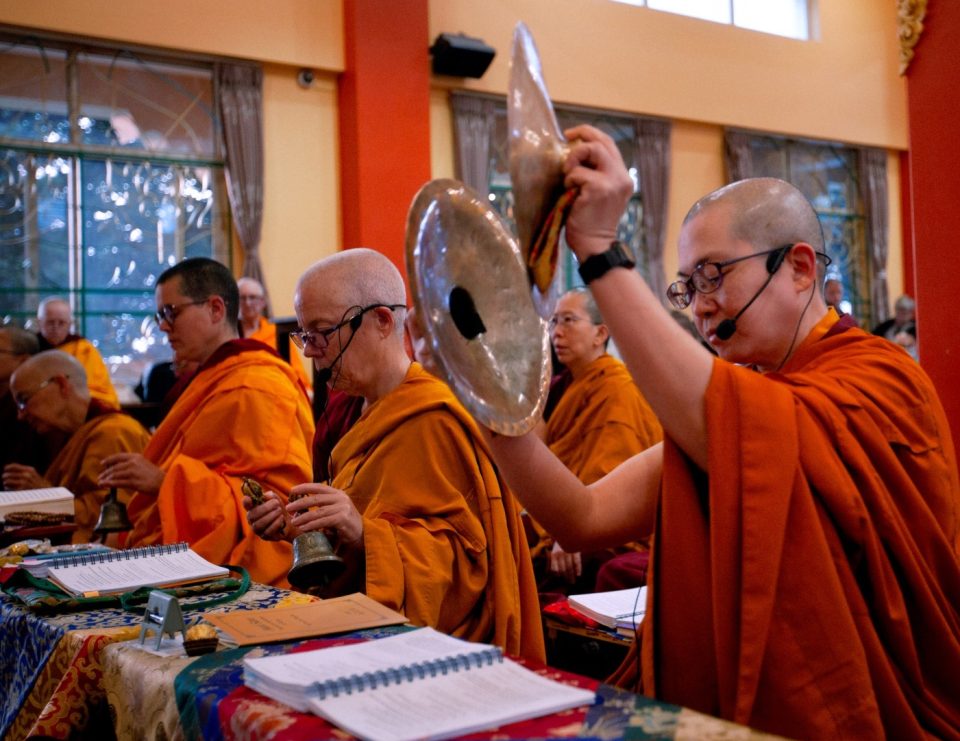
Ven. Joan and Ven. Dechen leading the chants during the Heart Sutra Retreat. Photo by Kira Dane.
The afternoons consisted of three sessions of meditation, each forty-five minutes in length. These were introduced by Ven. Steve, who provided us with profound nuggets to contemplate based on his many years of studying and teaching emptiness. A short series of preliminary prayers, including Praise to Manjushri, preceded the slow chanting in English of the Heart Sutra up to the point where we paused to meditate. Over the course of the four afternoons, we spent several sessions meditating first on “Form is emptiness,” then “Emptiness is form,” followed by “Emptiness is not other than form; form is also not other than emptiness.” Eventually we made it to “In the same way, feeling” where we paused to contemplate “Emptiness is not other than feeling” and so forth. The emptiness of discrimination, compositional factors, and consciousness, as well as the rest of phenomena, remains for us to contemplate in future retreats!
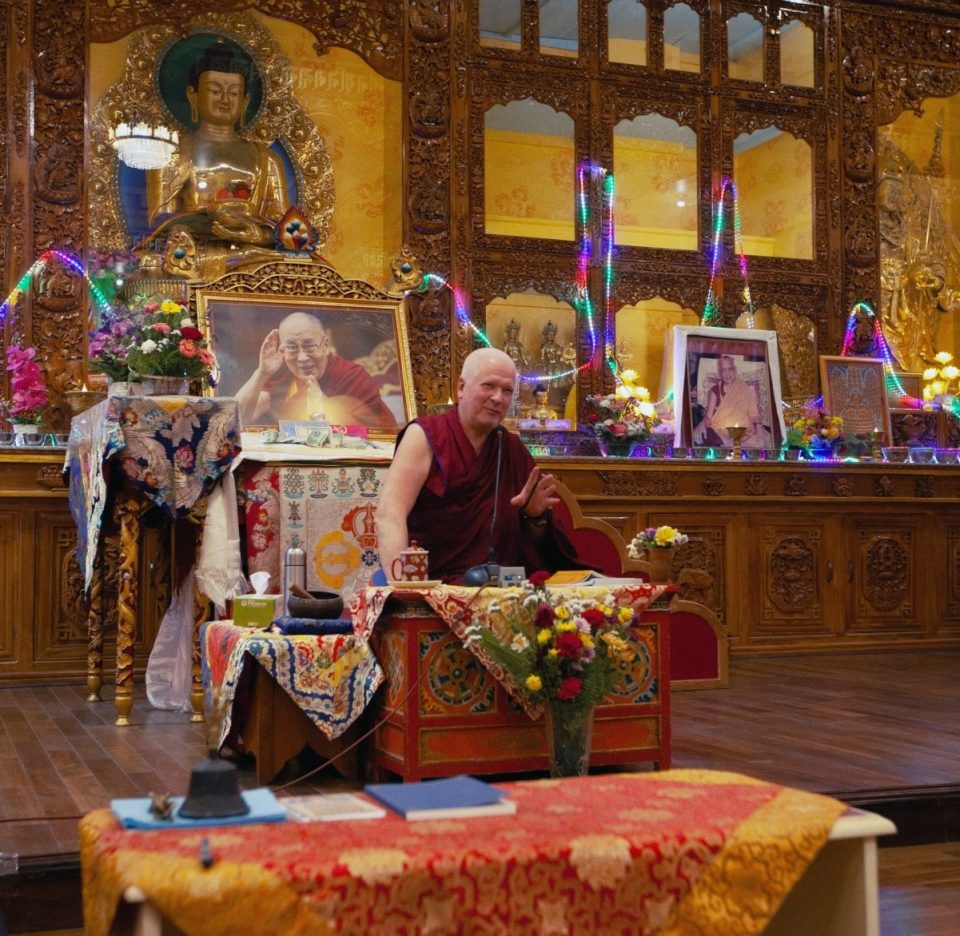
Ven. Steve Carlier teaching during the Heart Sutra Retreat at Kopan Monastery. Photo by Kira Dane.
Khen Rinpoche Geshe Chonyi, abbot of Kopan, kindly came to do a Q & A session one afternoon. The difficult questions posed by both old and new students gave us a glimpse of Khen Rinpoche’s great depth of knowledge and his skill in presenting the Dharma to a modern audience.
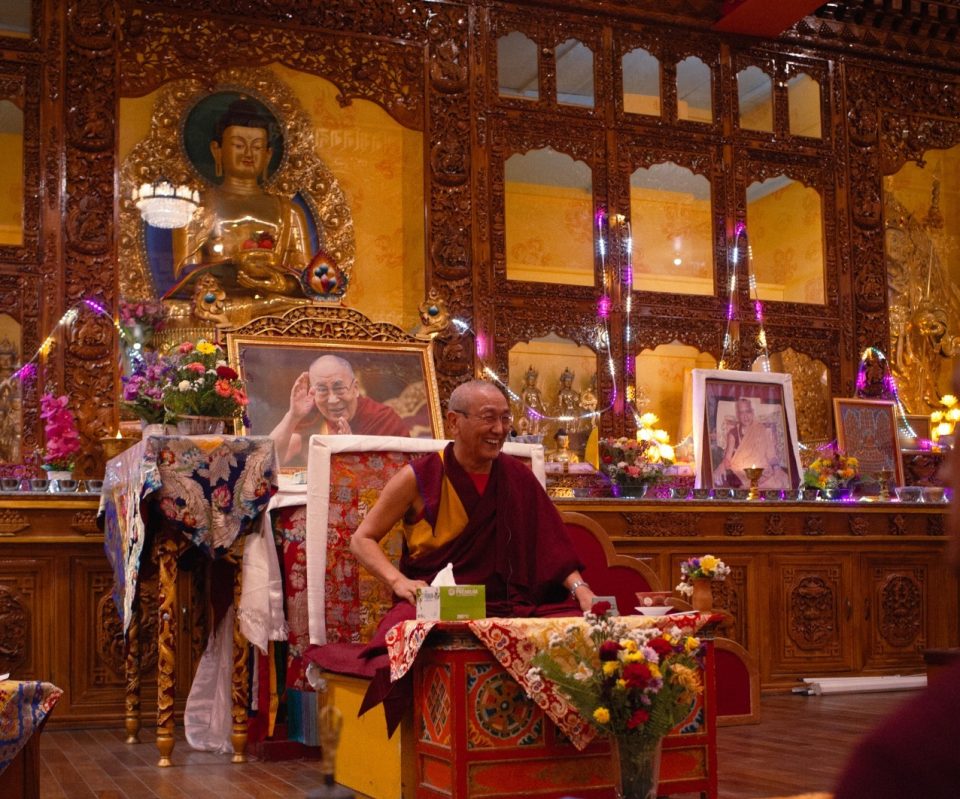
Khen Rinpoche Geshe Chonyi offering a Q & A during the Heart Sutra Retreat at Kopan Monastery. Photo by Kira Dane.
The evening sessions began with a short subtitled video of Lama Zopa Rinpoche teaching a topic related to emptiness. Rinpoche’s highly animated and expressive, and sometimes humorous, way of teaching topics such as the emptiness of red and green traffic lights made Rinpoche’s presence very much felt by all of us. (These videos will be released to the public soon.) Ven. Steve spent the rest of the session answering questions, generously sharing his extensive knowledge with us.
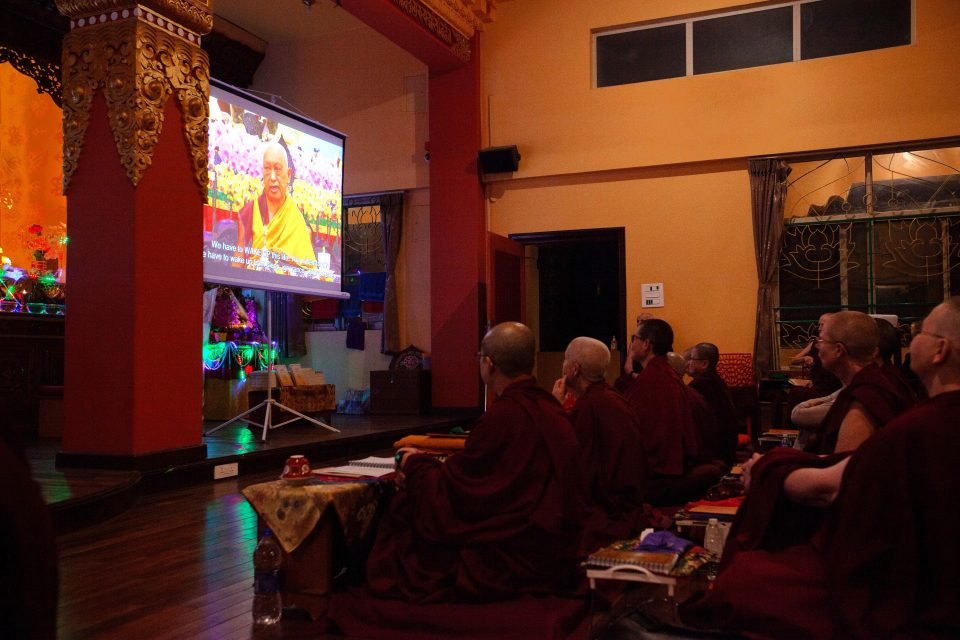
Heart Sutra Retreat participants viewing one of the extracted short videos of Lama Zopa Rinpoche teaching on emptiness. Photo by Kira Dane.
Unfortunately the retreat also gave many people a chance to contemplate the human suffering of sickness as a highly contagious stomach bug, also present in Kathmandu, swept through the group. For some it passed in twenty-four hours, but for others it even resulted in a visit to the hospital due to the resulting dehydration.
The retreat ended on the morning of April 20 with a final teaching on the Heart Sutra by Tri Rinpoche. It was followed by a group photo of the Heart Sutra retreat participants together with Tri Rinpoche.

Heart Sutra Retreat participants with His Eminence the 104th Ganden Tripa, April 2024. Photo courtesy of Kopan Monastery.
Afterward Khen Rinpoche took the opportunity to tell retreat participants about Kopan’s many charitable projects. Ven. Steve thanked everyone for their support during the retreat, and then led the group in final dedications, including the King of Prayers and the swift return prayer for Lama Zopa Rinpoche. Ven. Kalden then thanked everyone who contributed to making the retreat a success, including the cooks and kitchen staff who had gone out of their way to make sure we enjoyed good and healthy food throughout the retreat.
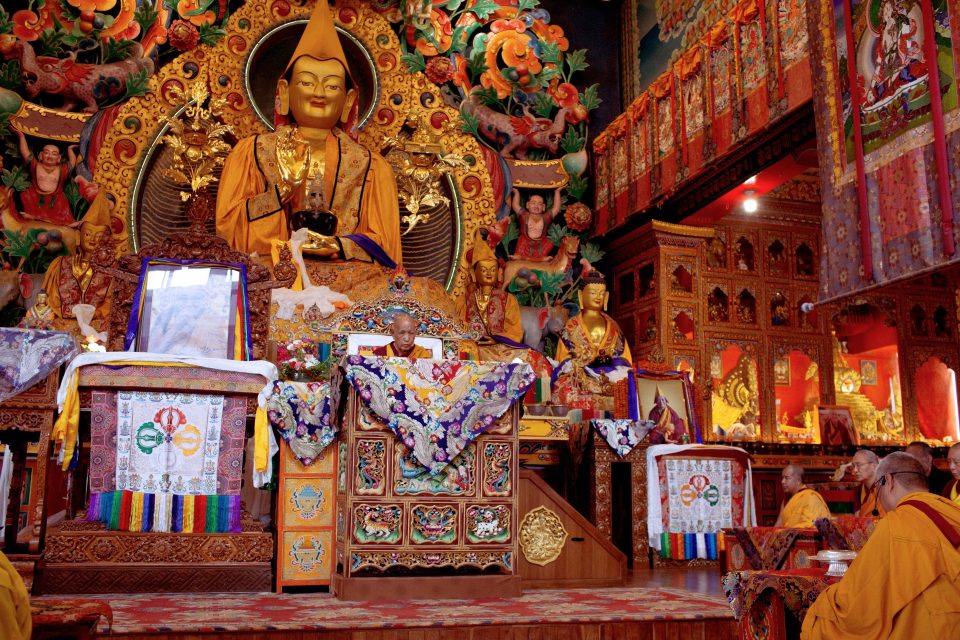
His Eminence the 104th Ganden Tripa teaching during the Heart Sutra Retreat at Kopan Monastery. Photo by Kira Dane.
The next morning a long life puja organized by Kopan was held in honor of Tri Rinpoche. Although, being based on the short Sixteen Arhat Puja, it was a relatively brief puja, all the traditional long life offerings were presented to Tri Rinpoche by the Kopan monks and nuns. As he had done during the teachings, Tri Rinpoche left the gompa in a wheelchair smiling and waving happily to the people on either side of the aisle.
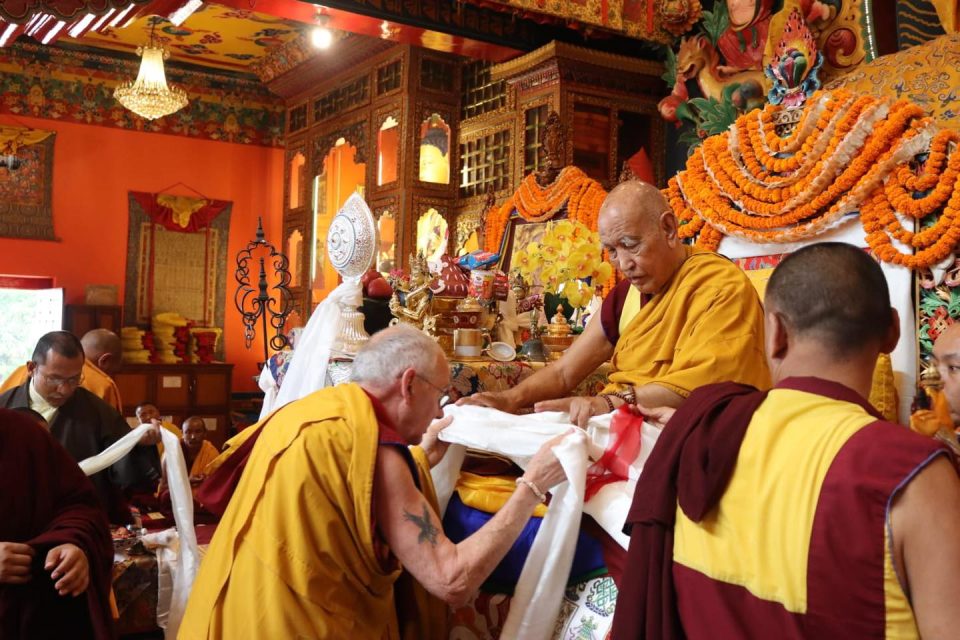
Ven. Roger Kunsang offering to His Eminence the 104th Ganden Tripa during the long life puja held at Kopan Monastery, April 21, 2024. Photo courtesy of Kopan Monastery.
May we always be able to fulfill our holy guru’s holy wishes by studying, contemplating, and meditating on the holy Dharma!
Grateful thanks to Kopan Monastery for offering this inspiring report of the retreat.
A booklet with instructions by Lama Zopa Rinpoche for doing a retreat related to the Heart Sutra can be found here:
https://shop.fpmt.org/Heart-Sutra-Practices-and-Instructions-for-Retreat-PDF_p_1775.html
Foundation for the Preservation of Mahayana Tradition (FPMT), is a Tibetan Buddhist organization dedicated to the transmission of the Mahayana Buddhist tradition and values worldwide through teaching, meditation and community service.
- Tagged: heart sutra, heart sutra retreat
9
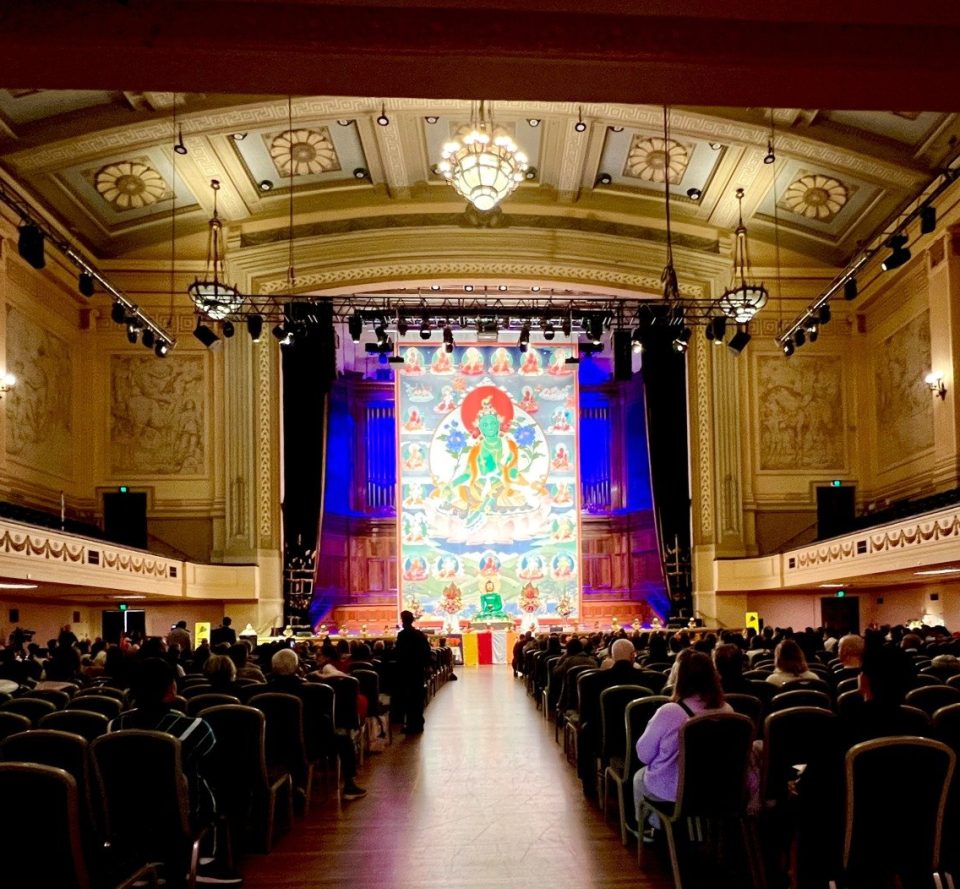
Display of the large Twenty-one Taras at the Melbourne Town Hall, 2023 Photo by Cynthia Karena.
In 2014, Lama Zopa Rinpoche commissioned Peter Iseli to paint a very big (49 ft x 30 ft) Twenty-One Taras thangka. Peter and his wife Jangchub Iseli-Sangmo spent four years creating the thangka, one section at a time, in a studio at Institut Vajra Yogini in France.

Large Twenty-One Tara thangka by artist Peter Iseli. Photo by Cynthia Karena.
At the end of 2017, Lama Zopa offered this thangka to Tara Institute in Melbourne, Australia, “to show to as many people as possible.”. In 2019 Peter made final changes requested by Rinpoche, and since then the thangka has been stored at Tara Institute.
Tara Institute displayed this thangka at the 2023 Victorian Celebration of the United Nations Day of Vesak at the Melbourne Town Hall. The event was a success and enjoyed by many, and we are pleased to share this will occur again this year on this Saturday May 11, 2024 honoring the same occasion and at the same venue!
Please enjoy a short video about this wonderful event.
Tara Institute will be posting reels and stories on their Instagram account throughout the day, starting with a livestream of loading the thangka onto the truck at 6 a.m.
Several FPMT centers have commissioned large thangkas and are now hosting festival days where these holy objects can be enjoyed. We invite you to rejoice in the displaying of these magnificent holy objects which was one of Lama Zopa Rinpoche’s Vast Visions for the FPMT organization. As Rinpoche has explained, doing this makes it “so easy for sentient beings to purify their heavy negative karma and making it so easy for sentient beings to create extensive merit. Which makes it so easy to achieve the realizations of the path and so easy to achieve liberation and enlightenment.”
Foundation for the Preservation of Mahayana Tradition (FPMT), is a Tibetan Buddhist organization dedicated to the transmission of the Mahayana Buddhist tradition and values worldwide through teaching, meditation and community service.
26
In this final chapter, “Touching Our Inner Beauty,” Ven. René Feusi answers the questions, “How do we peel back the layers of our consciousness to reveal the luminous essence of our being?” “How can awareness not only open our hearts but also cultivate a gentle embrace of ourselves and others?” Ven. René explores these topics, sharing practical techniques that serve not just as teachings but as tools for life.
Please watch Ven. Rene’s talk, “Touching Our Inner Beauty”
https://youtu.be/Y5VUwSbSNrA?feature=shared
You can also explore all six teachings in the Wisdom Dialogues series including inspiring hour-long talks from, in addition to Ven. René Feusi, Ven. Robina Courtin, Ven. Thubten Wangdu, Paula Chichester, Kabir Saxena, and Martin Strom.
Foundation for Developing Compassion and Wisdom (FDCW) provides secular training, programs and resources across many sectors of society – schools, universities, hospices, workplaces, healthcare, youth groups and community centers.
- Tagged: fdcw
24
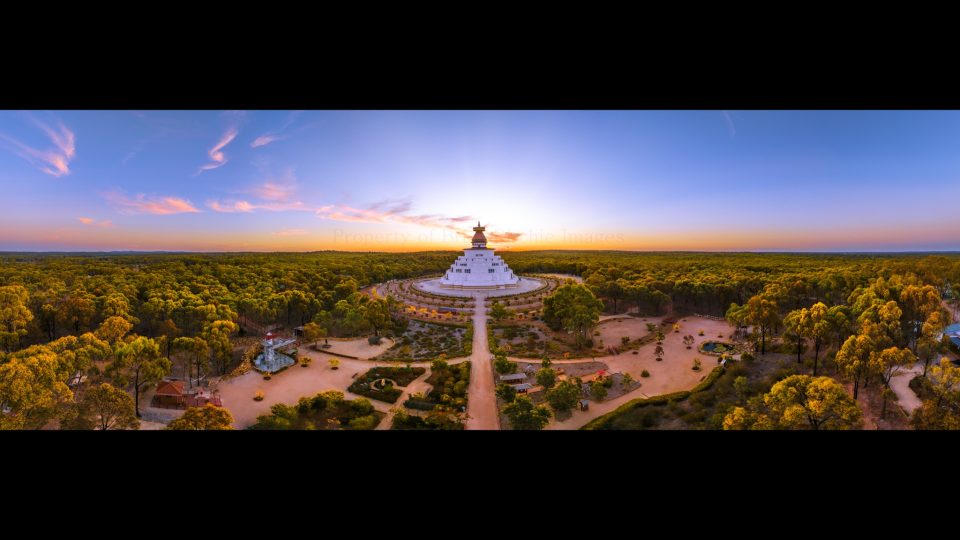
Drone image of the Great Stupa of Universal Compassion. Photo by Brett Ritchie.
The Great Stupa of Universal Compassion, being built near Bendigo Australia, is 50 meters (164 feet) square at its base and nearly 50 meters high. This makes it the largest stupa in the Western World. This stupa is the same design and size as the Gyantse Stupa (Kumbum) in Tibet. The Gyantse Stupa is one of the treasures of the Buddhist world.
We are pleased to share a recent update from Great Stupa director, Ian Green:
Drone Video
We are pleased to share a drone compilation of the Great Stupa of Universal Compassion, shot by Brett Ritchie. You can watch it in 4K by selecting the “cog” on the bottom row of options directly under the video.
Please watch the drone compilation video of the Great Stupa:
https://youtu.be/0qCbFCU27Bg?feature=shared
Kalachakra Mandala Ceiling
The ceiling of the Great Stupa gompa is 20 meters x 20 meters (66 x 66 feet). This whole space will be covered with a Kalachakra mandala. The mandala is being painted on polycarbonate panels which are 2 meters (6.5 feet) square. There will be 100 of these panels suspended to make the ceiling. The mandala will be presented three-dimensional so that different levels of the mandala will be on different levels. Lighting will be incorporated into the mandala to create a spectacular effect. While the mandala itself is strictly traditional, the way it is being presented on this enormous ceiling is being modernized to take advantage of modern materials.
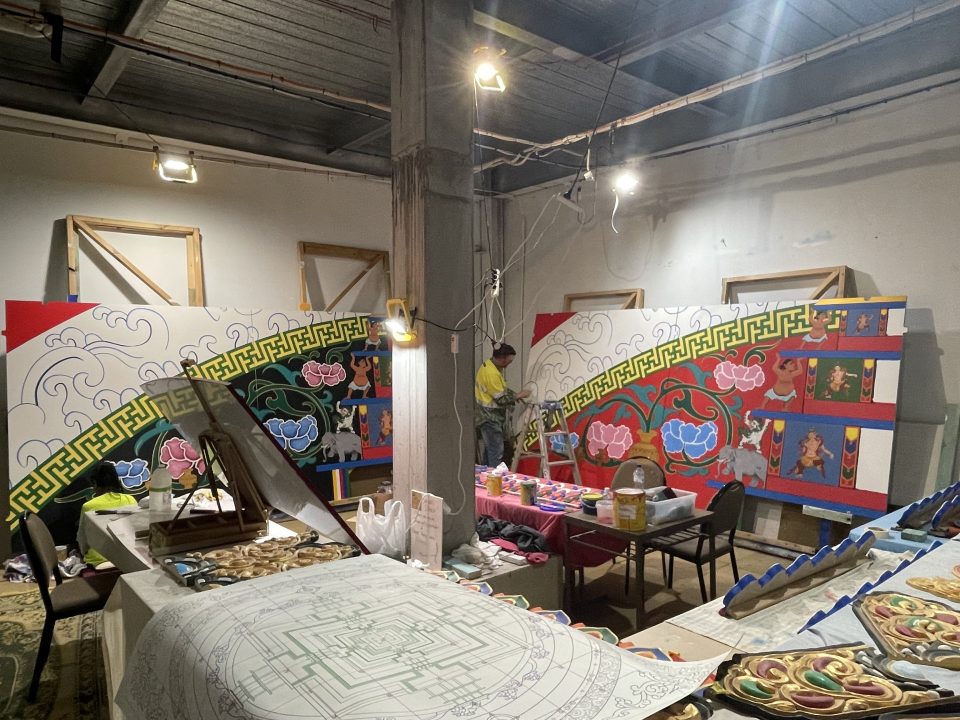
Painting of the Kalachakra ceiling panels. Photo courtesy of the Great Stupa of Universal Compassion.
The painting of the panels is being undertaken by a team of around 10 volunteers who are led and coordinated by Garrey Foulkes, the artistic director, and Guy Lawson the project manager. These skilled artists have been at work in Bendigo and in Queensland for nearly 12 months and their work is currently 50% complete. The ceiling will be complete for the Kalachakra initiation which will be led by Jhado Rinpoche inside the Great Stupa in September 2025.
Bumpa Door Frames
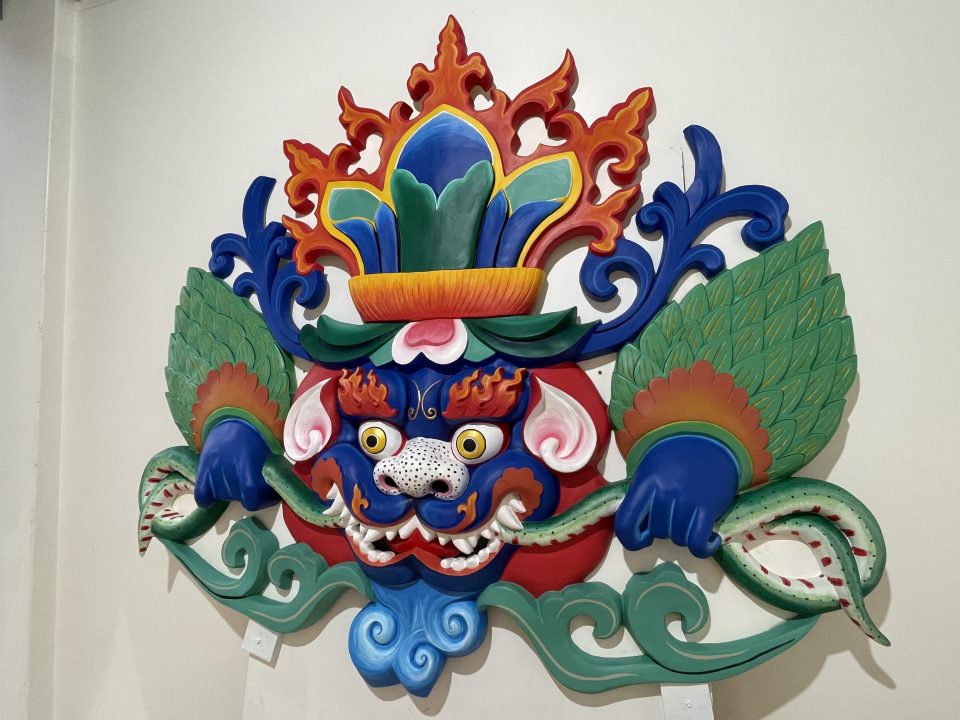
Bumpa door frames. Photo courtesy of the Great Stupa of Universal Compassion.
The door frames on the Bumpa (level 6) of the Great Stupa have been crafted to be replicas of the frames on the Gyantse Kumbum in Tibet. These massive frames are around 5.5 meters (18 feet) high. Work on the frames was completed in Vietnam and the art team under the leadership of Finn Matthews and Guy Lawson are meticulously painting them to be even more spectacular than the original door frames in Gyantse. Work is ongoing and we intend for the frames to be erected by the end of 2024.
Lightshows at the Great Stupa
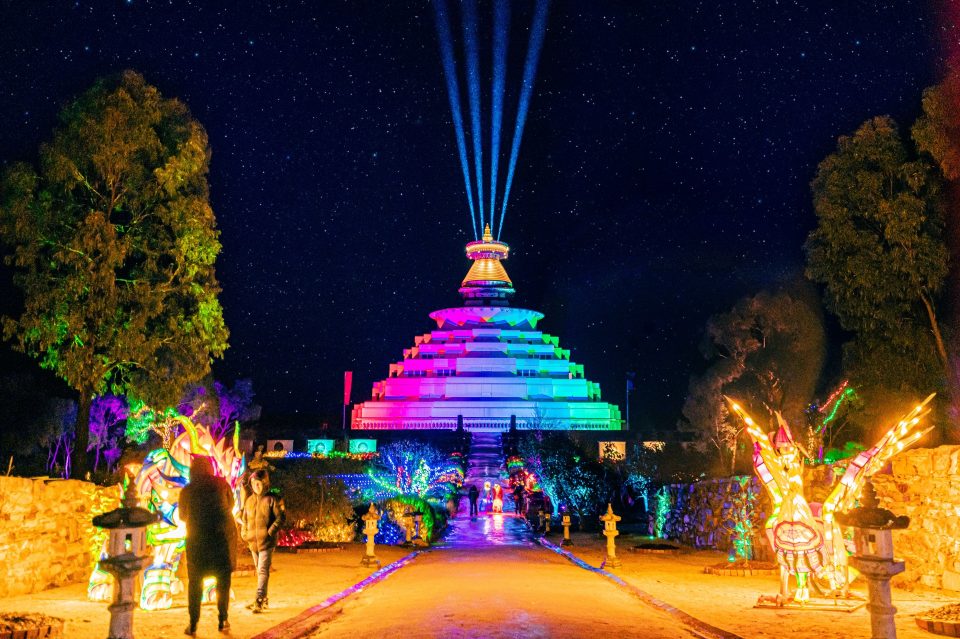
Light show at the Great Stupa of Universal Compassion.
Lightshows at the Great Stupa offer elaborate lighting throughout the Peace Park and spectacular lights on the stupa itself. These lightshows, which are called Illumin8 and Enlighten, occur on many occasions throughout the year and are sell-out events with people traveling far to experience this magical and uplifting presentation.
Bodhidhamma Vihara
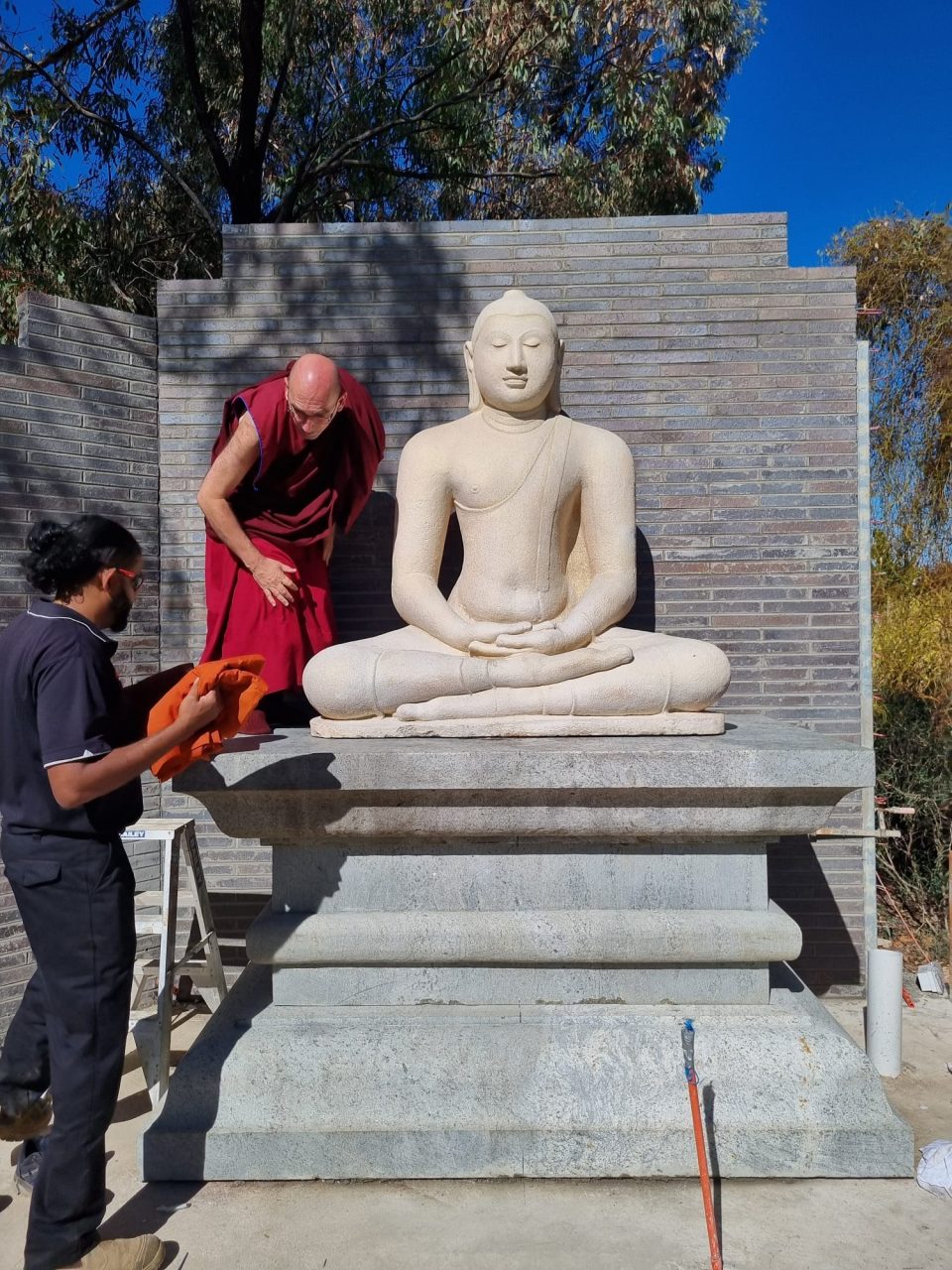
The Buddha statue is installed in Bodhi Dhamma Vihara, a Sri Lankan community project on the grounds of the Great Stupa. Photo courtesy of the Great Stupa of Universal Compassion.
Interfaith harmony is a major component of the Great Stupa‘s presentation to visitors. We believe that this conviction relates as much to harmony amongst Buddhist traditions as between different faiths. When the local Sri Lankan Buddhist community approached us about their need to find some land for a much needed vihara (temple or place of worship) in the Bendigo region, we were pleased to offer them the use of some of the land belonging to the Great Stupa for that purpose. Kyabje Lama Zopa Rinpoche was very pleased that this cooperation was happening.
This sharing of the land is symbolic of harmony between our two Buddhist traditions and also between our two cultures and countries. The Great Stupa has worked cooperatively with the Bodhidhamma Vihara Bendigo team on the establishment of the vihara and in doing so we have enriched our spiritual and cultural lives.
A large ceremony to mark the planting of the sapling of Jaya Shri Maha Bodhi, the most sacred tree in Sri Lanka, in the vihara site at the Great Stupa will take place on June 6. 2024. This event will be attended by the Prime Minister of Sri Lanka, the Premier of the State of Victoria, along with leading sangha from Sri Lanka, representatives of the interfaith community, ambassadors, and various leaders of federal, state, and local government.
We hope that the harmonious relationship between the Great Stupa and the Bodhidhamma Vihara will be an inspiration to Buddhists and people all over the world, illustrating that by working together, it is possible to build a positive connection that lasts for hundreds, if not thousands, of years.
To learn more about the Great Stupa of Universal Compassion, visit the website:
www.stupa.org.au
19
April 2024 E-News is Available Now!
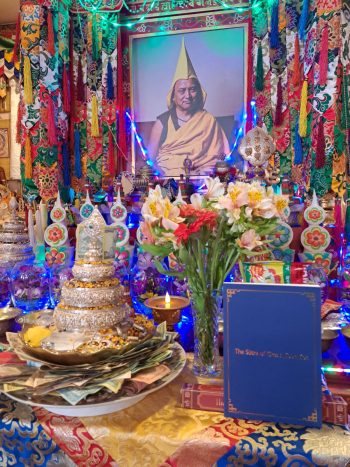
The first copy of a special limited edition of 300 copies of the Sutra of Great Liberation, printed in English by Amitabha Buddhist Centre students for the occasion of the commemoration of Lama Zopa Rinpoche showing the aspect of passing away, was offered to the holy body of Rinpoche at Kopan Monastery, April 12, 2024. Photo courtesy of ABC.
This month’s e-news brings you important news, updates, and causes for rejoicing regarding:
- One year anniversary of Lama Zopa Rinpoche showing the aspect of passing away
- Teachings by Lama Zopa Rinpoche and Lama Yeshe
- Heart Sutra Retreat at Kopan Monastery
- Grants offered through FPMT Charitable Projects in 2023
- Asia Regional Consultations at Kopan Monastery
- International Merit Box Project – collection season has started for this year’s grants
- Opportunities and changes within the organization
and much more!
Please read this month’s e-news in its entirety.
Have the e-News translated into your native language by using our convenient translation facility located on the right-hand side of the page.
Visit our subscribe page to receive the monthly FPMT International Office e-News directly in your email inbox.
- Tagged: fpmt enews
15
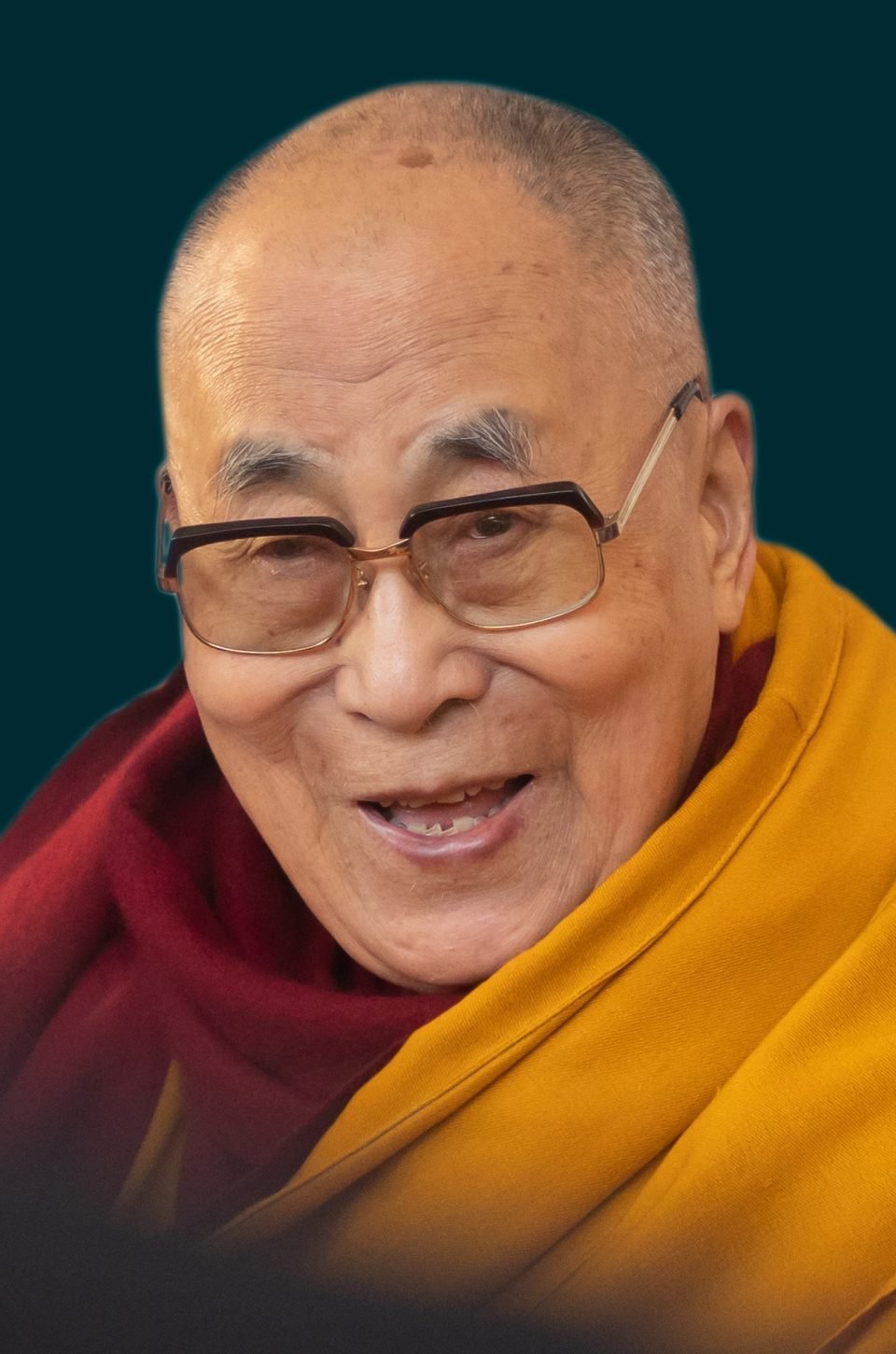
His Holiness the Dalai Lama portrait. Photo by Ven. Lobsang Sherab.
His Holiness the Dalai Lama will offer teachings on 100 Deities of Tushita Heaven (gaden lhagyama) on April 19 and 20, 2024 at the Main Tibetan Temple, McLeod Ganj, Dharamshala, starting at 8:00 am IST both days.
For full information please visit: dalailama.com/live
Webcast will be available in English and also in: Tibetan, Chinese, Vietnamese, Hindi, Korean, Japanese, Spanish, French, German, Russian, Italian, Nepali, Ladakhi and Mongolian.
100 Deities of Tushita Heaven text is a available to download in:
English, Tibetan, and Chinese
You can follow important and inspiring news about His Holiness the Dalai Lama on the official website of His Holiness:
https://www.dalailama.com/news
We invite you to follow the teaching schedule of His Holiness on the Office of His Holiness the Dalai Lama’s official website.
- Tagged: his holiness, his holiness the dalai lama
11
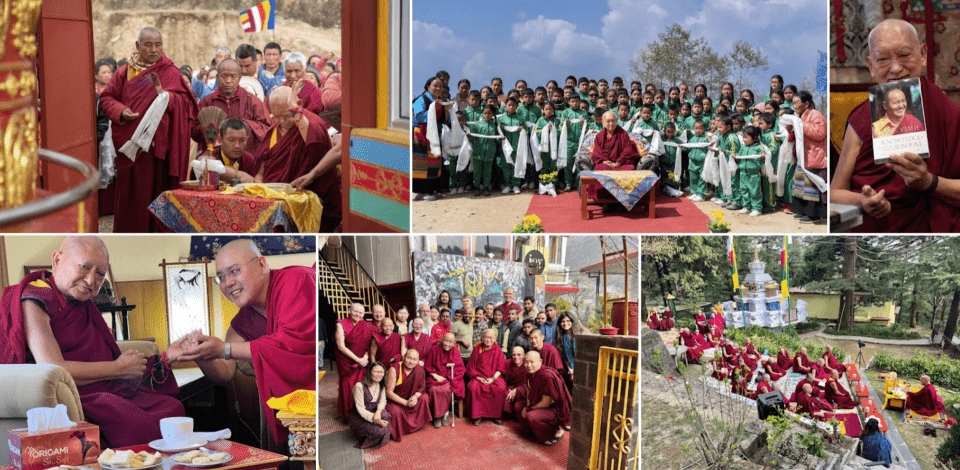
Photos from our 2023 photo galleries.
2023 was an extremely impactful year for for the entire FPMT organization as we navigated some unprecedented challenges following the sudden news of Lama Zopa Rinpoche entering his final meditation on April 13, 2023.
As the one year anniversary of Rinpoche showing the aspect of passing away approaches, we wanted to share two galleries of photos from 2023, which we created for this year’s Annual Review.
Please view all the photos in Gallery 1, and Gallery 2.
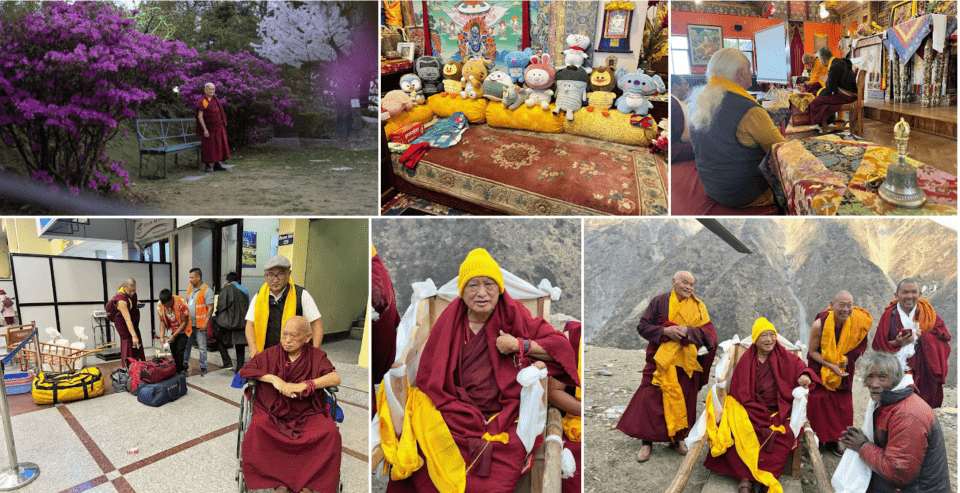
Photos from our 2023 photo galleries.
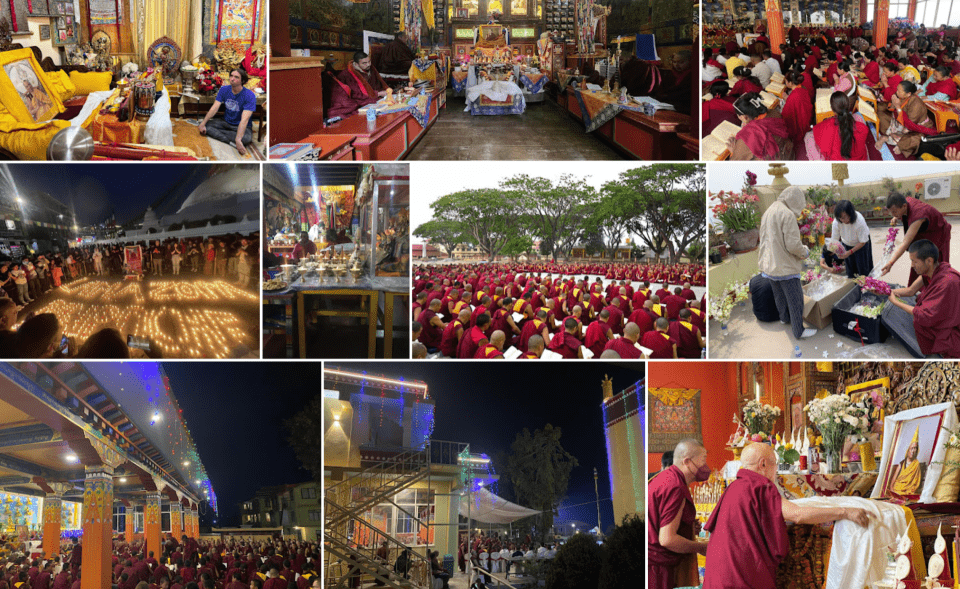
Photos from our 2023 photo galleries.
We also invite you to view an inspiring four part photo gallery of Lama Zopa Rinpoche through the years.
Foundation for the Preservation of Mahayana Tradition (FPMT), is a Tibetan Buddhist organization dedicated to the transmission of the Mahayana Buddhist tradition and values worldwide through teaching, meditation and community service.
- Tagged: photo gallery
15
Please Read Our March 2024 e-News
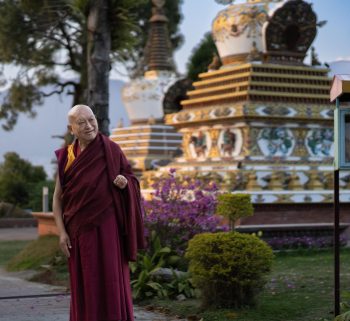
Lama Zopa Rinpoche at Kopan Monastery, March 25, 2023. Photo by Ven. Lobsang Sherab.
This issue of our monthly e-news brings you news, resources, and special announcements including:
- Reminder about the upcoming anniversary of Lama Zopa Rinpoche passing away
- A teaching by Lama Yeshe
- Our 2023 Annual Review
- An update from the FPMT Inc. Board of Directors
- Newly available and revised materials
- Changes and opportunities in the organization
And much more!
Please read this month’s e-news in its entirety.
Visit our subscribe page to receive the FPMT International Office News directly in your email inbox.
Foundation for the Preservation of Mahayana Tradition (FPMT), is a Tibetan Buddhist organization dedicated to the transmission of the Mahayana Buddhist tradition and values worldwide through teaching, meditation and community service.
- Tagged: fpmt enews
14
2023 Annual Review Is Now Available!
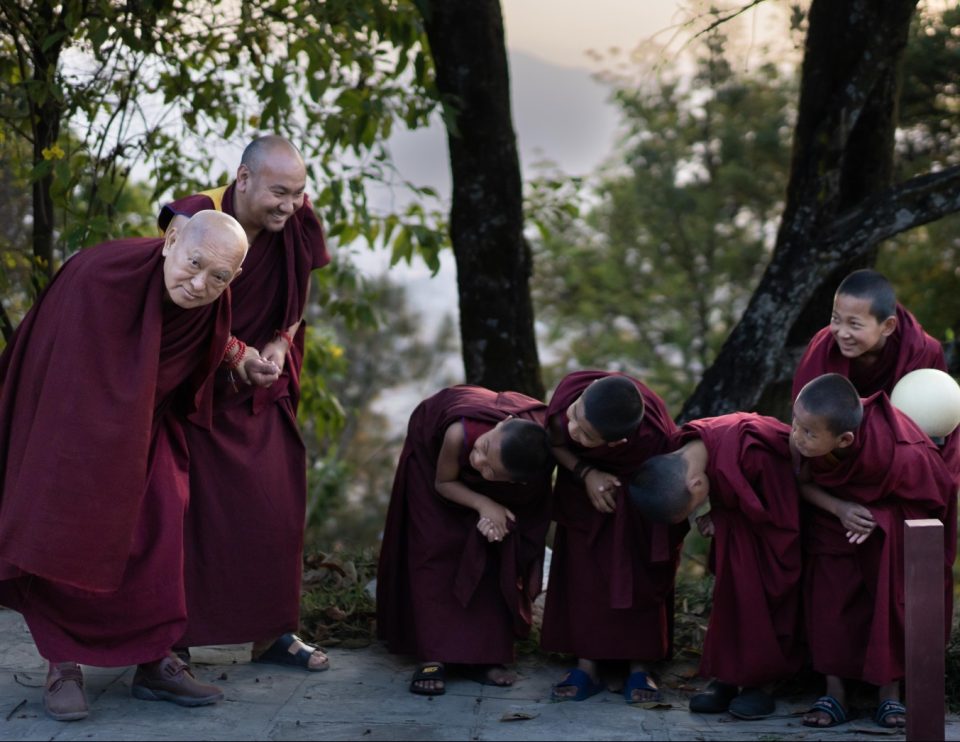
Lama Zopa Rinpoche trying to bow lower than the young monks on the way to the stupa, Kopan Monastery, March 25, 2023. Photo by Ven. Lobsang Sherab
We are happy to share this year’s Annual Review, “Repaying the Kindness, Looking to the Future.”
We invite you to take your time with the various reports as this was an unprecedented year and we have a lot to share and process in the sections of this year’s report.
As you will read in the many summaries included, we continued to offer access to our lamas’ teachings; kept the international community connected and informed about news and advice following the passing of Lama Zopa Rinpoche; offered guidance and structure to FPMT centers, projects, and services; facilitated charitable giving to many beneficial initiatives dedicated to helping others and based on the wishes of Rinpoche; and disseminated the Dharma to all who wish to receive it.
Please view our 2023 Annual Review and join us in rejoicing in another year of helping to actualize Lama Yeshe’s and Lama Zopa Rinpoche’s wishes for the FPMT organization and the world.
Please note, the FPMT Annual Review 2023 is available only online:
https://fpmt.org/fpmt/annual-review-2023/
Foundation for the Preservation of Mahayana Tradition (FPMT), is a Tibetan Buddhist organization dedicated to the transmission of the Mahayana Buddhist tradition and values worldwide through teaching, meditation and community service.
- Tagged: annual review, annual review 2023
- Home
- News/Media
- Study & Practice
- About FPMT Education Services
- Latest News
- Programs
- New to Buddhism?
- Buddhist Mind Science: Activating Your Potential
- Heart Advice for Death and Dying
- Discovering Buddhism
- Living in the Path
- Exploring Buddhism
- FPMT Basic Program
- FPMT Masters Program
- FPMT In-Depth Meditation Training
- Maitripa College
- Lotsawa Rinchen Zangpo Translator Program
- Universal Education for Compassion & Wisdom
- Online Learning Center
- Prayers & Practice Materials
- Overview of Prayers & Practices
- Full Catalogue of Prayers & Practice Materials
- Explore Popular Topics
- Benefiting Animals
- Chenrezig Resources
- Death & Dying Resources
- Lama Chopa (Guru Puja)
- Lama Zopa Rinpoche: Compendium of Precious Instructions
- Lama Zopa Rinpoche: Life Practice Advice
- Lama Zopa Rinpoche Practice Series
- Lamrim Resources
- Mantras
- Prayer Book Updates
- Purification Practices
- Sutras
- Thought Transformation (Lojong)
- Audio Materials
- Dharma Dates – Tibetan Calendar
- Translation Services
- Publishing Services
- Teachings and Advice
- Find Teachings and Advice
- Lama Zopa Rinpoche Advice Page
- Lama Zopa Rinpoche: Compendium of Precious Instructions
- Lama Zopa Rinpoche Video Teachings
- ༧སྐྱབས་རྗེ་བཟོད་པ་རིན་པོ་ཆེ་མཆོག་ནས་སྩལ་བའི་བཀའ་སློབ་བརྙན་འཕྲིན།
- Podcasts
- Lama Yeshe Wisdom Archive
- Buddhism FAQ
- Dharma for Young People
- Resources on Holy Objects
- Ways to Offer Support
- Centers
- Affiliates Area
- Teachers
- Projects
- Charitable Projects
- Make a Donation
- Applying for Grants
- News about Projects
- Other Projects within FPMT
- Support International Office
- Projects Photo Galleries
- Give Where Most Needed
- FPMT
- Shop
Translate*
*powered by Google TranslateTranslation of pages on fpmt.org is performed by Google Translate, a third party service which FPMT has no control over. The service provides automated computer translations that are only an approximation of the websites' original content. The translations should not be considered exact and only used as a rough guide.Buddhism is not saying that objects have no beauty whatsoever. They do have beauty. The craving mind, however, projects onto an object something that is beyond the relative level, which has nothing to do with that object. That mind is hallucinating, deluded and holding the wrong entity.







